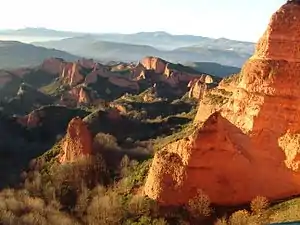Ruina montium
Ruina montium (Latin, "wrecking of mountains") was allegedly an ancient Roman mining technique that draws on the principle of Pascal's barrel.[1] Miners would excavate narrow cavities down into a mountain, whereby filling the cavities with water would cause pressures large enough to fragment thick rock walls.[2][3][4] It was described by Pliny the Elder (Natural History 33.21), who served as procurator in Spain.[5][6] However, there is little real evidence to show the method was used in northern Spain or elsewhere.

The landscape of Las Médulas is a result of hushing and natural erosion.
References
- Ancient Engineers' Inventions: Precursors of the Present (Springer, 2009), p. 135.
- Rossi, Cesare; Russo, Flavio; Russo, Russo (2009). Ancient Engineers' Inventions. 8. Springer. pp. 133–141. ISBN 978-90-481-2252-3.
- Cesare Rossi; Flavio Russo (26 August 2016). Ancient Engineers' Inventions: Precursors of the Present. Springer. pp. 185–192. ISBN 978-3-319-44476-5.
- Alfred Michael Hirt (25 March 2010). Imperial Mines and Quarries in the Roman World: Organizational Aspects 27 BC-AD 235. OUP Oxford. pp. 32–45. ISBN 978-0-19-957287-8.
- Pliny the Elder (1857) with John Bostock and H.T. Riley, trans., The Natural History of Pliny (London, England: Henry G. Bohn), vol. 6, Book 33, Ch. 21, pp. 101–104.
- John F. Healy (1999). Pliny the Elder on Science and Technology. Oxford University Press. pp. 275–290. ISBN 978-0-19-814687-2.
This article is issued from Wikipedia. The text is licensed under Creative Commons - Attribution - Sharealike. Additional terms may apply for the media files.